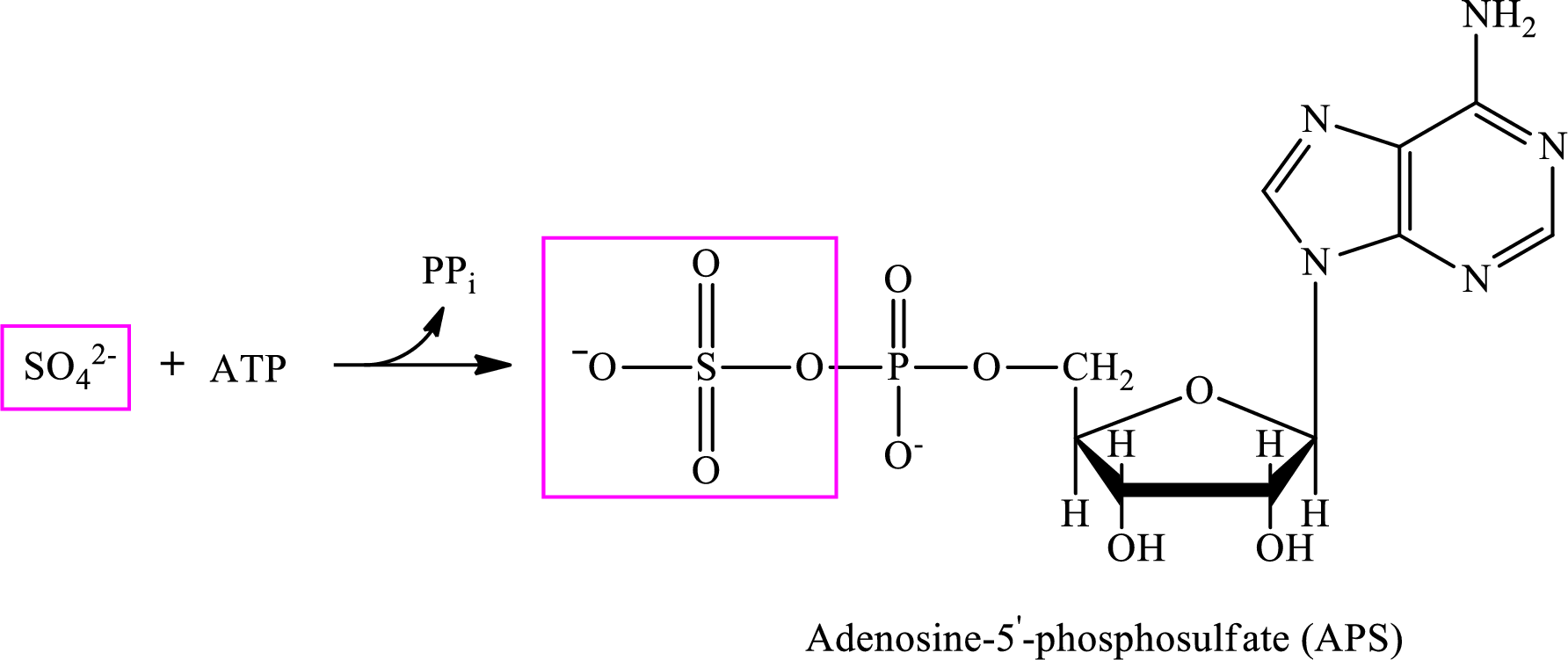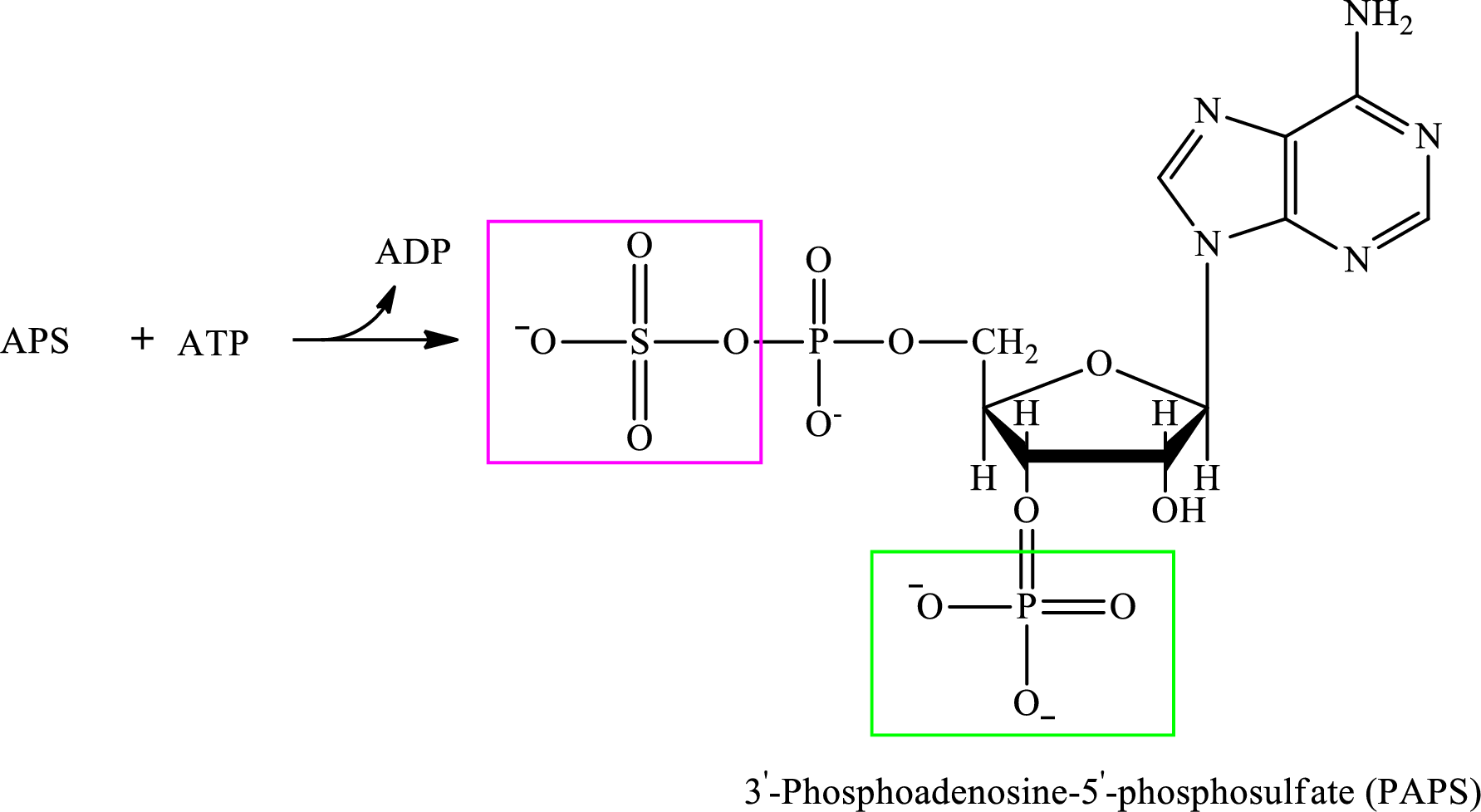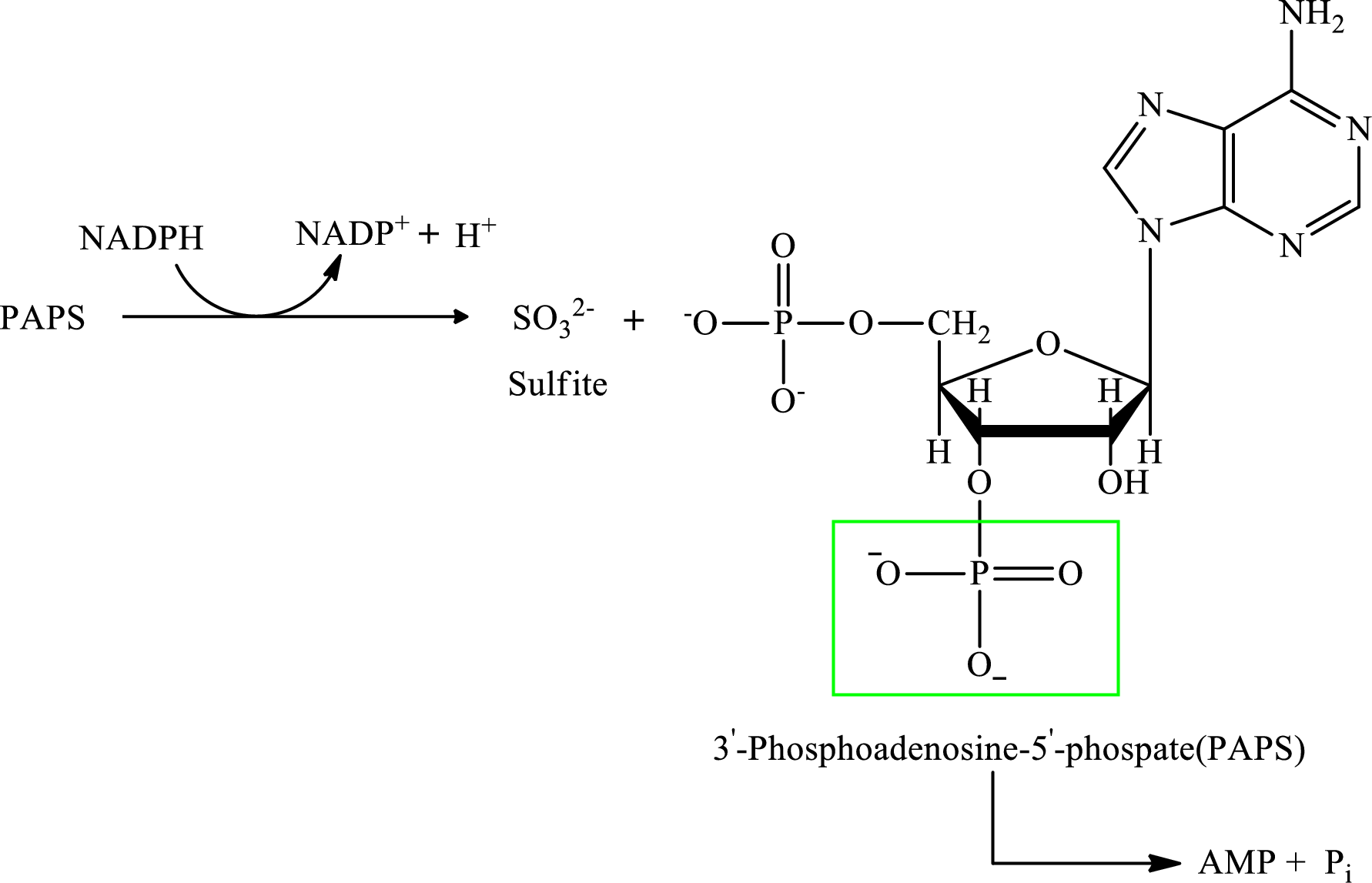
General, Organic, and Biological Chemistry
7th Edition
ISBN: 9781285853918
Author: H. Stephen Stoker
Publisher: Cengage Learning
expand_more
expand_more
format_list_bulleted
Concept explainers
Question
Chapter 26.8, Problem 3QQ
Interpretation Introduction
Interpretation: To determine the reactant in the first step of the sulfate assimilation process.
Concept introduction: Sulfate assimilation is the process used for the production of hydrogen sulfide. The starting material for sulfate assimilation is sulfate ion. It is an oxidation-reduction process as the sulfur in sulfate ion is in oxidized form and in hydrogen sulfide it is present in the reduced form.
The conversion of sulfate ion to sulfide ion via sulfate assimilation occurs in 4 steps. These steps are as follows:
Step 1:

Step 2:

Step 3:

Step 4:

Expert Solution & Answer
Want to see the full answer?
Check out a sample textbook solution
Students have asked these similar questions
5.
6.
0/5
alekscgi/x/sl.exe/1o_u-IgNglkr7j8P3jH-IQs_pBaHhvlTCeeBZbufuBYTi0Hz7m7D3ZcSLEFovsXaorzoFtUs | AbtAURtkqzol 1HRAS286,
O States of Matter
Sketching a described thermodynamic change on a phase diagram
The pressure on a sample of pure X held at 47. °C and 0.88 atm is increased until the sample condenses. The pressure is then held constant and the
temperature is decreased by 82. °C. On the phase diagram below draw a path that shows this set of changes.
3
pressure (atm)
+
0-
0
5+
200
temperature (K)
400
Explanation
Check
X
0+
F3
F4
F5
F6
F7
S
2025 McGraw Hill LLC All Rights Reserved. Terms of Use Privacy Center
Accessibility
Q Search
LUCR
+
F8
F9
F10
F11
F12
*
%
&
(
5
6
7
8
9
Y'S
Dele
Insert
PrtSc
+
Backs
Chapter 26 Solutions
General, Organic, and Biological Chemistry
Ch. 26.1 - Which of the following statements about dietary...Ch. 26.1 - Dietary protein materials as they leave the...Ch. 26.1 - The inactive form of pepsin is converted to its...Ch. 26.1 - Which of the following is not a proteolytic...Ch. 26.2 - The dominant use for the amino acids of the amino...Ch. 26.2 - The most abundant amino acid in the amino acid...Ch. 26.2 - Prob. 3QQCh. 26.3 - Prob. 1QQCh. 26.3 - Prob. 2QQCh. 26.3 - The net effect of transamination is to collect the...
Ch. 26.3 - Prob. 4QQCh. 26.3 - Prob. 5QQCh. 26.3 - Most aminotransferases are specific for the keto...Ch. 26.4 - Which of the following statements concerning the...Ch. 26.4 - Prob. 2QQCh. 26.4 - The two fuels for the urea cycle are a. carbamoyl...Ch. 26.4 - Prob. 4QQCh. 26.4 - Prob. 5QQCh. 26.4 - Prob. 6QQCh. 26.5 - Which of the following statements concerning the...Ch. 26.5 - Prob. 2QQCh. 26.5 - Prob. 3QQCh. 26.5 - Prob. 4QQCh. 26.6 - Prob. 1QQCh. 26.6 - How many of the standard amino acids are...Ch. 26.6 - The simplest pathways for amino acid biosynthesis...Ch. 26.7 - Prob. 1QQCh. 26.7 - Which of the following statements concerning the...Ch. 26.7 - Prob. 3QQCh. 26.7 - In the degradation of heme, the iron atom present...Ch. 26.8 - In degradation of the sulfur-containing amino acid...Ch. 26.8 - Prob. 2QQCh. 26.8 - Prob. 3QQCh. 26.8 - Prob. 4QQCh. 26.9 - Prob. 1QQCh. 26.9 - Prob. 2QQCh. 26.9 - Prob. 3QQCh. 26.10 - Prob. 1QQCh. 26.10 - Prob. 2QQCh. 26.10 - Prob. 3QQCh. 26 - Prob. 26.1EPCh. 26 - Indicate whether each of the following aspects of...Ch. 26 - Indicate whether each of the following pairings of...Ch. 26 - Indicate whether each of the following pairings of...Ch. 26 - Indicate whether each of the following statements...Ch. 26 - Prob. 26.6EPCh. 26 - Prob. 26.7EPCh. 26 - Prob. 26.8EPCh. 26 - Prob. 26.9EPCh. 26 - Prob. 26.10EPCh. 26 - Prob. 26.11EPCh. 26 - Prob. 26.12EPCh. 26 - Prob. 26.13EPCh. 26 - Prob. 26.14EPCh. 26 - Indicate whether each of the following situations...Ch. 26 - Indicate whether each of the following situations...Ch. 26 - Prob. 26.17EPCh. 26 - Prob. 26.18EPCh. 26 - Prob. 26.19EPCh. 26 - Prob. 26.20EPCh. 26 - Prob. 26.21EPCh. 26 - Prob. 26.22EPCh. 26 - Prob. 26.23EPCh. 26 - Prob. 26.24EPCh. 26 - Prob. 26.25EPCh. 26 - Prob. 26.26EPCh. 26 - Prob. 26.27EPCh. 26 - Prob. 26.28EPCh. 26 - Prob. 26.29EPCh. 26 - Prob. 26.30EPCh. 26 - Prob. 26.31EPCh. 26 - Prob. 26.32EPCh. 26 - Prob. 26.33EPCh. 26 - Prob. 26.34EPCh. 26 - Prob. 26.35EPCh. 26 - Prob. 26.36EPCh. 26 - Prob. 26.37EPCh. 26 - Prob. 26.38EPCh. 26 - Prob. 26.39EPCh. 26 - Prob. 26.40EPCh. 26 - Prob. 26.41EPCh. 26 - Prob. 26.42EPCh. 26 - Prob. 26.43EPCh. 26 - Draw the structure of the -keto acid produced from...Ch. 26 - Prob. 26.45EPCh. 26 - Prob. 26.46EPCh. 26 - Prob. 26.47EPCh. 26 - Prob. 26.48EPCh. 26 - Prob. 26.49EPCh. 26 - Prob. 26.50EPCh. 26 - Prob. 26.51EPCh. 26 - Prob. 26.52EPCh. 26 - Prob. 26.53EPCh. 26 - Prob. 26.54EPCh. 26 - Prob. 26.55EPCh. 26 - Prob. 26.56EPCh. 26 - Prob. 26.57EPCh. 26 - Prob. 26.58EPCh. 26 - Prob. 26.59EPCh. 26 - Prob. 26.60EPCh. 26 - Prob. 26.61EPCh. 26 - Prob. 26.62EPCh. 26 - Prob. 26.63EPCh. 26 - Prob. 26.64EPCh. 26 - Prob. 26.65EPCh. 26 - Prob. 26.66EPCh. 26 - Prob. 26.67EPCh. 26 - Prob. 26.68EPCh. 26 - Prob. 26.69EPCh. 26 - Prob. 26.70EPCh. 26 - Prob. 26.71EPCh. 26 - Prob. 26.72EPCh. 26 - Prob. 26.73EPCh. 26 - Prob. 26.74EPCh. 26 - Prob. 26.75EPCh. 26 - Prob. 26.76EPCh. 26 - Prob. 26.77EPCh. 26 - Prob. 26.78EPCh. 26 - Prob. 26.79EPCh. 26 - Prob. 26.80EPCh. 26 - Prob. 26.81EPCh. 26 - Prob. 26.82EPCh. 26 - Prob. 26.83EPCh. 26 - Prob. 26.84EPCh. 26 - Prob. 26.85EPCh. 26 - Prob. 26.86EPCh. 26 - Prob. 26.87EPCh. 26 - Prob. 26.88EPCh. 26 - Prob. 26.89EPCh. 26 - Prob. 26.90EPCh. 26 - Prob. 26.91EPCh. 26 - Prob. 26.92EPCh. 26 - Prob. 26.93EPCh. 26 - Prob. 26.94EPCh. 26 - Prob. 26.95EPCh. 26 - Prob. 26.96EPCh. 26 - Prob. 26.97EPCh. 26 - Which bile pigment is responsible for the...Ch. 26 - Prob. 26.99EPCh. 26 - Prob. 26.100EPCh. 26 - Prob. 26.101EPCh. 26 - Prob. 26.102EPCh. 26 - Prob. 26.103EPCh. 26 - Prob. 26.104EPCh. 26 - Prob. 26.105EPCh. 26 - Prob. 26.106EPCh. 26 - Prob. 26.107EPCh. 26 - Prob. 26.108EPCh. 26 - Prob. 26.109EPCh. 26 - Prob. 26.110EPCh. 26 - Prob. 26.111EPCh. 26 - Prob. 26.112EPCh. 26 - Prob. 26.113EPCh. 26 - Prob. 26.114EPCh. 26 - Prob. 26.115EPCh. 26 - Prob. 26.116EP
Knowledge Booster
Learn more about
Need a deep-dive on the concept behind this application? Look no further. Learn more about this topic, chemistry and related others by exploring similar questions and additional content below.Similar questions
- 5.arrow_forward9arrow_forwardalekscgi/x/lsl.exe/1o_u-IgNslkr7j8P3jH-IQs_pBanHhvlTCeeBZbufu BYTI0Hz7m7D3ZS18w-nDB10538ZsAtmorZoFusYj2Xu9b78gZo- O States of Matter Sketching a described thermodynamic change on a phase diagram 0/5 The pressure on a sample of pure X held at 47. °C and 0.88 atm is increased until the sample condenses. The pressure is then held constant and the temperature is decreased by 82. °C. On the phase diagram below draw a path that shows this set of changes. pressure (atm) 3- 200 temperature (K) Explanation Chick Q Sowncharrow_forward
- 0+ aleksog/x/lsl.exe/1ou-lgNgkr7j8P3H-IQs pBaHhviTCeeBZbufuBYTOHz7m7D3ZStEPTBSB3u9bsp3Da pl19qomOXLhvWbH9wmXW5zm O States of Matter Sketching a described thermodynamic change on a phase diagram 0/5 Gab The temperature on a sample of pure X held at 0.75 atm and -229. °C is increased until the sample sublimes. The temperature is then held constant and the pressure is decreased by 0.50 atm. On the phase diagram below draw a path that shows this set of changes. F3 pressure (atm) 0- 0 200 Explanation temperature (K) Check F4 F5 ☀+ Q Search Chill Will an 9 ENG F6 F7 F8 F9 8 Delete F10 F11 F12 Insert PrtSc 114 d Ararrow_forwardx + LEKS: Using a phase diagram a X n/alekscgi/x/lsl.exe/10_u-IgNsikr7j8P3jH-IQs_pBan HhvlTCeeBZbufu BYTI0Hz7m7D3ZcHYUt80XL-5alyVpw ○ States of Matter Using a phase diagram to find a phase transition temperature or pressure Use the phase diagram of Substance X below to find the melting point of X when the pressure above the solid is 1.1 atm. pressure (atm) 16 08- solid liquid- 0 200 400 gas 600 temperature (K) Note: your answer must be within 25 °C of the exact answer to be graded correct. × 5arrow_forwardS: Using a phase diagram leksogi/x/sl.exe/1ou-IgNs kr 7j8P3jH-IQs_pBan HhvTCeeBZbufuBYTI0Hz7m7D3ZdHYU+80XL-5alyVp O States of Matter Using a phase diagram to find a phase transition temperature or pressure se the phase diagram of Substance X below to find the boiling point of X when the pressure on the liquid is 1.6 atm. pressure (atm) 32- 16- solid liquid 0. gas 100 200 temperature (K) 300 Note: your answer must be within 12.5 °C of the exact answer to be graded correct. 10 Explanation Check § Q Search J 2025 McGraw Hill LLC. All Rights Researrow_forward
- 151.2 254.8 85.9 199.6 241.4 87.6 242.5 186.4 155.8 257.1 242.9 253.3 256.0 216.6 108.7 239.0 149.7 236.4 152.1 222.7 148.7 278.2 268.7 234.4 262.7 283.2 143.6 QUESTION: Using this group of data on salt reduced tomato sauce concentration readings answer the following questions: 1. 95% Cl Confidence Interval (mmol/L) 2. [Na+] (mg/100 mL) 3. 95% Na+ Confidence Interval (mg/100 mL)arrow_forwardResults Search Results Best Free Coursehero Unloc xb Success Confirmation of Q x O Google Pas alekscgi/x/lsl.exe/1o_u-IgNslkr 7j8P3jH-IQs_pBanHhvlTCeeBZbufu BYTI0Hz7m7D3ZcHYUt80XL-5alyVpwDXM TEZayFYCavJ17dZtpxbFD0Qggd1J O States of Matter Using a phase diagram to find a phase transition temperature or pressure Gabr 3/5 he pressure above a pure sample of solid Substance X at 101. °C is lowered. At what pressure will the sample sublime? Use the phase diagram of X below to nd your answer. pressure (atm) 24- 12 solid liquid gas 200 400 temperature (K) 600 ote: your answer must be within 0.15 atm of the exact answer to be graded correct. atm Thanation Check © 2025 McGraw Hill LLC. All Rights Reserved. Terms of Use | Privacy Center I Q Search L³ ملةarrow_forward301.7 348.9 193.7 308.6 339.5 160.6 337.7 464.7 223.5 370.5 326.6 327.5 336.1 317.9 203.8 329.8 221.9 331.7 211.7 309.6 223.4 353.7 334.6 305.6 340.0 304.3 244.7 QUESTION: Using this group of data on regular tomato sauce concentration readings answer the following questions: 1. 95% Cl Confidence Interval (mmol/L) 2. [Na+] (mg/100 mL) 3. 95% Na+ Confidence Interval (mg/100 mL)arrow_forward
- Search Results Search Results Best Free Coursehero Unlo x b Success Confirmation of Q aleks.com/alekscgi/x/sl.exe/10_u-lgNslkr7j8P3jH-IQs_pBan HhvlTCeeBZbufu BYTIOHz7m7D3ZcHYUt80XL-5alyVpwDXM TEZayFYCav States of Matter Using a phase diagram to find a phase transition temperature or pressure Use the phase diagram of Substance X below to find the temperature at which X turns to a gas, if the pressure above the solid is 3.7 atm. pressure (atm) 0. 32- 16 solid liquid gas 200 temperature (K) Note: your answer must be within 20 °C of the exact answer to be graded correct. Дос Xarrow_forwardConsider the reaction below to answer the following questions: Acetoacetic ester can be prepared by the Claisen self-condensation reaction of ethyl acetate. 1. NaOEt, EtOH H&C OCH CH3 2 H30 H3C CH2 OCH2CH3 A. Write the complete stepwise mechanism for this reaction. Show all electron flow with arrows and draw all intermediate structures. B. Ethyl acetate can be prepared from ethanol as the only organic starting material. Show all reagents and structures for all intermediates in this preparation. C. Give the structures of the ester precursors for the following Claisen condensation product and formulate the reaction. OEtarrow_forwardUse the phase diagram of Substance X below to find the temperature at which X turns to a gas, if the pressure above the solid is 3.7 atm. pressure (atm) 32 16 solid liquid gas 0 0 200 temperature (K) Note: your answer must be within 20 °C of the exact answer to be graded correct. Шос ☑ كarrow_forward
arrow_back_ios
SEE MORE QUESTIONS
arrow_forward_ios
Recommended textbooks for you
 General, Organic, and Biological ChemistryChemistryISBN:9781285853918Author:H. Stephen StokerPublisher:Cengage Learning
General, Organic, and Biological ChemistryChemistryISBN:9781285853918Author:H. Stephen StokerPublisher:Cengage Learning Organic And Biological ChemistryChemistryISBN:9781305081079Author:STOKER, H. Stephen (howard Stephen)Publisher:Cengage Learning,
Organic And Biological ChemistryChemistryISBN:9781305081079Author:STOKER, H. Stephen (howard Stephen)Publisher:Cengage Learning,

General, Organic, and Biological Chemistry
Chemistry
ISBN:9781285853918
Author:H. Stephen Stoker
Publisher:Cengage Learning

Organic And Biological Chemistry
Chemistry
ISBN:9781305081079
Author:STOKER, H. Stephen (howard Stephen)
Publisher:Cengage Learning,